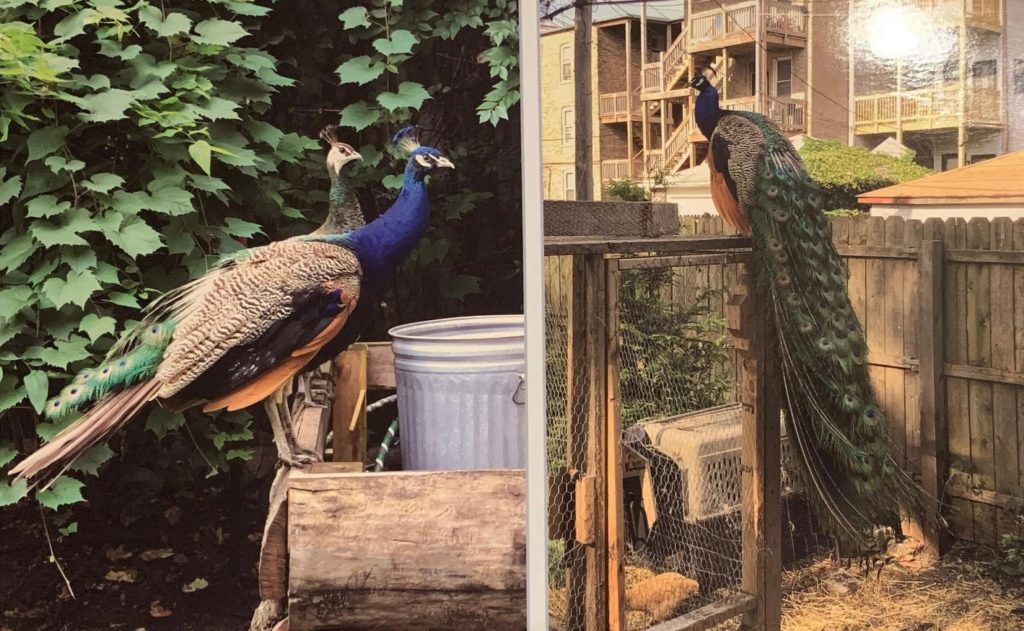
This Resource Is Not Meant To Be A Comprehensive Treatment Of Peafowl Care!
In this resource we wish to provide caregivers with a general introduction to how peafowl have come to need the care and attention of rescuers and farmed animal sanctuariesAnimal sanctuaries that primarily care for rescued animals that were farmed by humans., as well as some background to their history, social lives and behaviors in the wild to help assist caregivers with some basic necessary considerations in considering whether they should, and how they should care for peafowl.
Introduction
While peafowl with their magnificent plumage and regal demeanor may not be the first animal that you envision when you think of farmed animalsA species or specific breed of animal that is raised by humans for the use of their bodies or what comes from their bodies. in need of sanctuary, it is an unfortunate reality that they too have been subjected to exploitationExploitation is characterized by the abuse of a position of physical, psychological, emotional, social, or economic vulnerability to obtain agreement from someone (e.g., humans and nonhuman animals) or something (e.g, land and water) that is unable to reasonably refuse an offer or demand. It is also characterized by excessive self gain at the expense of something or someone else’s labor, well-being, and/or existence. by humans. Male peafowl, commonly known as peacocks, have been used for their flesh, their feathers, and even as an “alarm system” or “predator protection” for hobby and other backyard bird keepers, due to their loud calls. Female peafowl, known as peahens, are also exploited for their flesh, feathers, and their eggs.
Peafowl seem to be a recent popular addition to the “backyard poultry” trend. When unknowledgeable keepers take on peafowl and find themselves unprepared to handle this species’ specific needs and behaviors, these birds can often end up dumped, surrendered to shelters, or otherwise in need of homes. As a result there seems to be a general uptick recently in requests to sanctuaries and rescues to intervene when it comes to peafowl. It is important for any sanctuary receiving a rescue request for this species to understand that the needs of peafowl are distinct from those of other avian residents. The first step to doing this is to familiarize yourselves with the background and history of these birds, so that you can provide them with the best and most appropriate care possible.
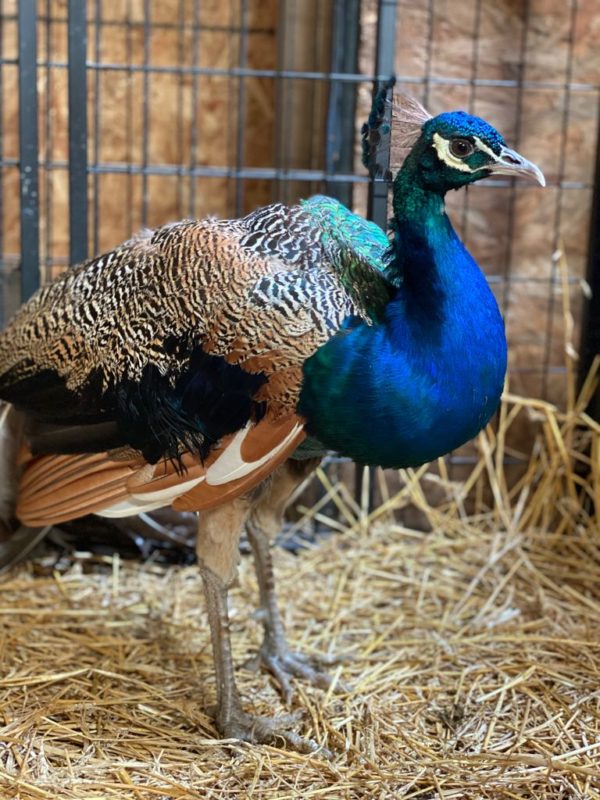
There are three known species of peafowl:
- The “blue” or Indian peafowl, which is the national bird of India, with a range spanning across both India and Sri Lanka. The Indian peacock (male) has a bright blue head and neck along with a long “train” that is covered in spots that resemble eyes, known as “ocelli,” which they use to attract a mate. The Indian peahen (female) has a much more muted coloration and is largely brown, with a green neck. Both have small fanned crests. Humans have selectively bred Indian peafowl to exhibit color mutations, including white. This is the species most commonly kept by humans, and the most likely species you will encounter.
- The “green” or Javanese peafowl, which ranges from Myanmar to Java. These resemble the “blue” Indian peacock, but with green necks instead of blue.
- The Congo or African peafowl lives in the Democratic Republic of the Congo. The male is a bright metallic blue, and has fourteen tail feathers. Like the other two species, the female is similarly subdued in coloration relative to the male. The adults of this species may resemble juveniles of either the blue Indian peafowl, or the green Javanese peafowl
All three species are members of the Phasianidae family, which include other heavy and largely ground living birds such as pheasants, partridges, and Jungle Fowl, the ancestors of the modern day chicken. Another thing that all three peafowl species have in common with each other (and with Jungle Fowl) is that they all come from hot climates, which can range from tropical to dry.
Sadly, similar to the wild ancestors of chickens, Red Jungle Fowl, the native habitat of peafowl is under threat. Due to the proliferation of blue Indian peafowl across the world because of human “domestication,” they are not currently considered to be at risk of extinction. However green Javanese peacocks are considered to be endangered and Congo peacocks are considered vulnerable to extinction. There are additional similarities and also some key differences between how peafowl found their way around the world and how chickens became domesticated, which are worth noting and have important implications for the compassionate care of all of these birds.
What Makes Peafowl Unique?
Like the ancestors of chickens, peafowl (specifically blue Indian peafowl) have been carried and introduced all around the world by humans since ancient times (with ancient Greek mythology noting the peacock as the symbol of the goddess Hera, for example.) Also like the ancestors of chickens, peafowl thrive in hot climates, and are largely ground dwelling birds. What this means for compassionate caregivers of these species is that both chickens and peafowl require careful care when it comes to extreme cold. Despite their ubiquitousness throughout the world, neither chickens nor peafowl should be left to the mercy of the elements when it comes to extreme cold, and they require special care in cold temperatures.
Peafowl can be extremely large (and physically very strong) relative to chickens. With regards to blue Indian peafowl, peahens can range from 35 to 43 inches in length with a wingspan of 31 to 51 inches. They can weigh 6 to 8.8 pounds. Peacocks range from 70 to 98 inches in length, with a train that can reach up to 63 inches! Peacocks’ wingspans can range from 51 to 63 inches, and they can weigh from 8 to 13 pounds.
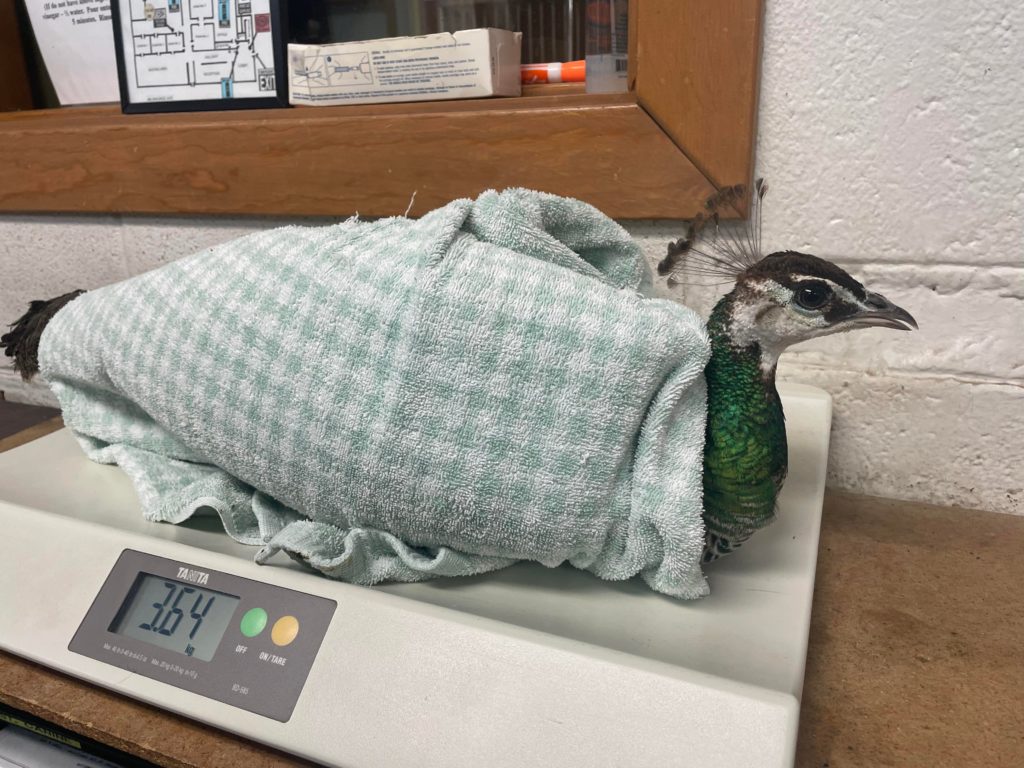
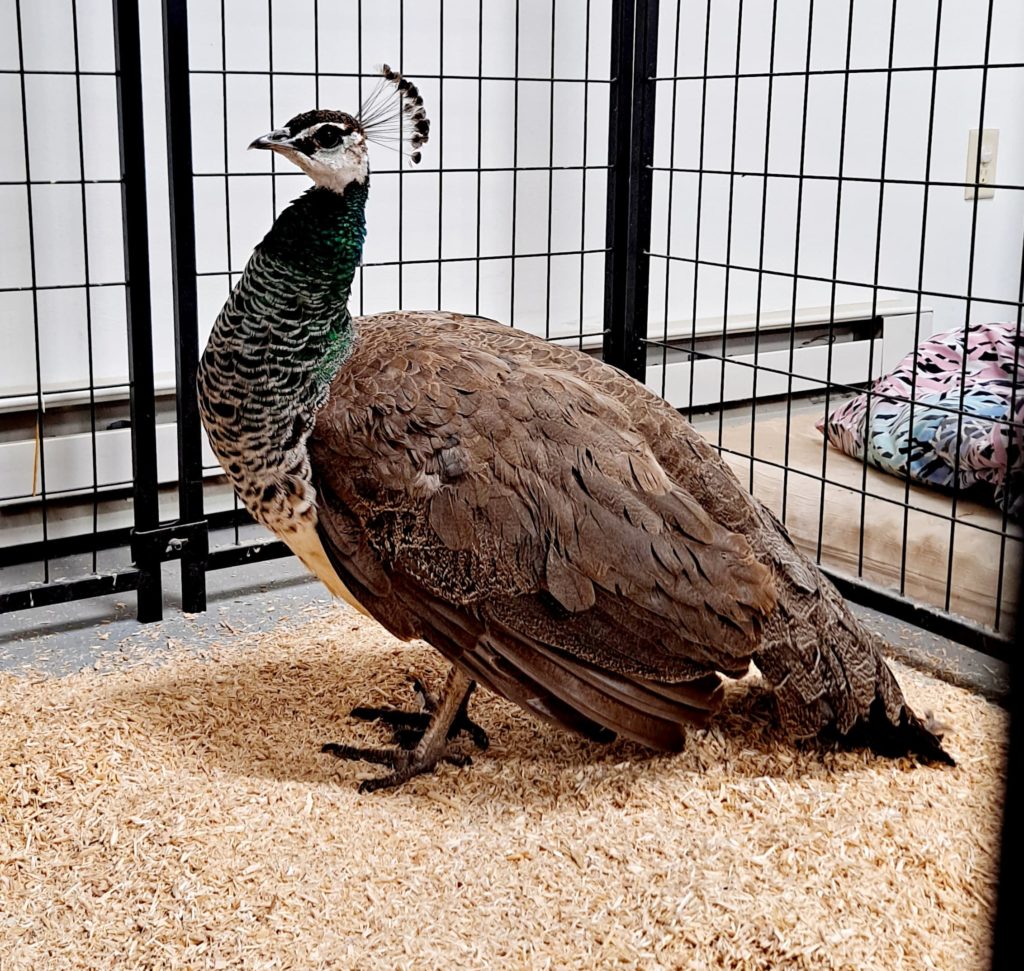
However, unlike chickens, peafowl have not been selectively bred in the same intensive manner. While chickens have been selectively bred over time in ways that have drastically altered their bodies to both increase “production” (both in terms of egg-laying and in terms of rapid growth for meat production) peafowl have not been manipulated through breeding as extensively. For chickens, intensive selective breeding means that their lifespans have been significantly shortened by the health concerns that humans have imposed upon them. While chickens’ Junglefowl ancestors have been documented to live up to 15 to 20 years old, their domesticatedAdapted over time (as by selective breeding) from a wild or natural state to life in close association with and to the benefit of humans family members tend to live much shorter lives.
In contrast, peafowl tend to have very long lifespans, and are more similar to parrots in this way. Wild peafowl have been documented to live from 10 to 25 years. Those living in compassionate care conditions, with protection from predators and with appropriate veterinary care, have been documented to live as long as 40 to 50 years old. It is incredibly important to keep in mind the potentially long lifespan of peafowl when it comes to keeping them as sanctuary residents. It is always crucial to plan for the lifelong care of any resident, including estimating species lifetime care costs, but particularly so when the resident in question can have a lifespan as long as that of a peafowl.
One way in which peafowl have been impacted by domestication, however, is that some humans selectively breed peafowl with unusual coloration, including breeding all white birds. Dumped white birds are at a special risk of predation, especially at night. While any dumped bird is at significant risk, and can be considered to be in an emergency situation, if you are notified with regard to dumped white peafowl, please consider this to be a particularly urgent emergency, as such birds stand out dramatically to predators due to their size and coloration.

General Care Considerations For Peafowl
What do peafowls’ relative closeness to their wild family mean for compassionate caregivers? While this resource is meant as an introduction to peafowl, and not to offer comprehensive care recommendations for this species, there are a few important generalizations that we can offer here. First, in terms of peafowl behavior, because peafowl kept by humans are very close to their wild relatives, anyone considering peafowl residents should remember that in terms of how they may relate to their human caregivers, peafowl are likely to behave very differently from more domesticated birds. They are unlikely to be as social with human caregivers as chickens or domesticated ducksUnless explicitly mentioned, we are referring to domesticated duck breeds, not wild ducks, who may have unique needs not covered by this resource. or turkeysUnless explicitly mentioned, we are referring to domesticated turkey breeds, not wild turkeys, who may have unique needs not covered by this resource. may be, although every resident is an individual, and there may be exceptions to this general rule. But in general, please keep in mind that as beautiful and enticing as peafowl are, they are unlikely to welcome human advances or affection, and should never be forced to do so. Given their size and strength, they can also inflict significant damage on caregivers making unwanted advances on them.
In terms of their lifestyle, like most birds, wild peafowl live in social groups of their own kind (Fun fact: a group of peafowl can be known as either a muster, an ostentation, or a pride), and they are birds of habit, following a daily routine involving foraging in the morning and evening. The peafowl diet is omnivorous, and in addition to eating plants and fruits, peafowl will eat insects, small creatures like rodents, amphibians and reptiles and have even been known to attack and consume small snakes. This means that they will require a higher protein diet than other avian residents like chickens, and food designed for domesticated chickens will not likely suffice to meet their nutritional needs.
During the heat of midday, peafowl may preen, dust bathe, and seek cooler temperatures in the shade. As a result, they should be offered enrichment opportunities in their living spaces so that they may engage in these behaviors. Overnight, they roost in groups, sometimes at surprising heights in trees. This brings us to another important fact about peafowl, which has to do with their surprising abilities with regard to flight:
It is a widespread myth that peafowl cannot fly, perhaps because of assumptions made around their size and the impressive length and weight of the tail of peacocks. As a matter of fact, peafowl can both jump and fly fairly well! Peafowl will usually start their flight by a leap from the ground. Impressively, peafowl have been documented to jump up to eight feet high. With this head start and a combination of flapping from their powerful wings, peafowl have been known to fly up to a mile at a time. What does this mean for would-be caregivers of peafowl?
First of all, if you are called upon to rescue peafowl, you should keep their ability to fly in mind. Catching an able-bodied peafowl in daytime is extremely difficult. The best bet is to identify where they have chosen to roost, and to wait for them to do so at night. And bring a ladder and large nets! It’s extremely likely that peafowl will roost in an area outside of your reach, so in order to catch them it is best to have a team of multiple people who can sneak up on sleeping peafowl with a combination of ladders and netting to bring them to safety. Keep in mind that peafowl are extremely strong, and can injure rescuers when they are not appropriately secured.
When it comes to designing living spaces for peafowl, there are additional considerations. It’s important to provide peafowl with a living spaceThe indoor or outdoor area where an animal resident lives, eats, and rests. that accommodates their desire to roost in higher spots, and that can also keep them safely confined. This may mean taller aviaries than you might build for other avian residents, such as most breeds of chickens, and it may well mean enclosing these aviaries carefully with avian netting or roofing at the top which can both keep peafowl safe from overhead predators, prevent them from flying out of their enclosures, and which are also designed in a fashion to protect them from potentially getting caught or hitting themselves in the case that they are startled and leap or fly into the air. Peafowl in particular may benefit from animal centered design work and concepts.
What about social behavior? Understanding how wildliving peafowl interact can be very helpful in offering them proper accommodation in sanctuary. In terms of seasonal behavior, in their natural habitat, peafowl engage in courtship and mating behaviors when monsoons commence in their region. Social behaviors can change dramatically during these times. In their non-breeding season, peafowl tend to segregate themselves into larger separate groups of all peahens, or all peacocks. When breeding season comes up (in the United States, peafowl tend to breed in spring) peacocks begin to actively exhibit some of the behaviors for which they are most famed.
These include both impressive auditory and visual displays. In terms of visual displays, in order to attract the attention of potential peahen mates, peacocks will fan and quiver their impressive tails and dance in the fashion that has made them famed throughout the world. As a fun related note, when peacocks engage in this behavior, it emits a sound that is known as “train rattling” which is vaguely like a drum roll, causing a vibration in the air that peahens can literally feel! The frequency of this “train rattling” will then cause the crests of both the peacock and the peahen to vibrate in unison! This particular mating behavior is surely enchanting and entrancing, but mating season does come with other behaviors that may be more of a challenge if you have nearby neighbors!
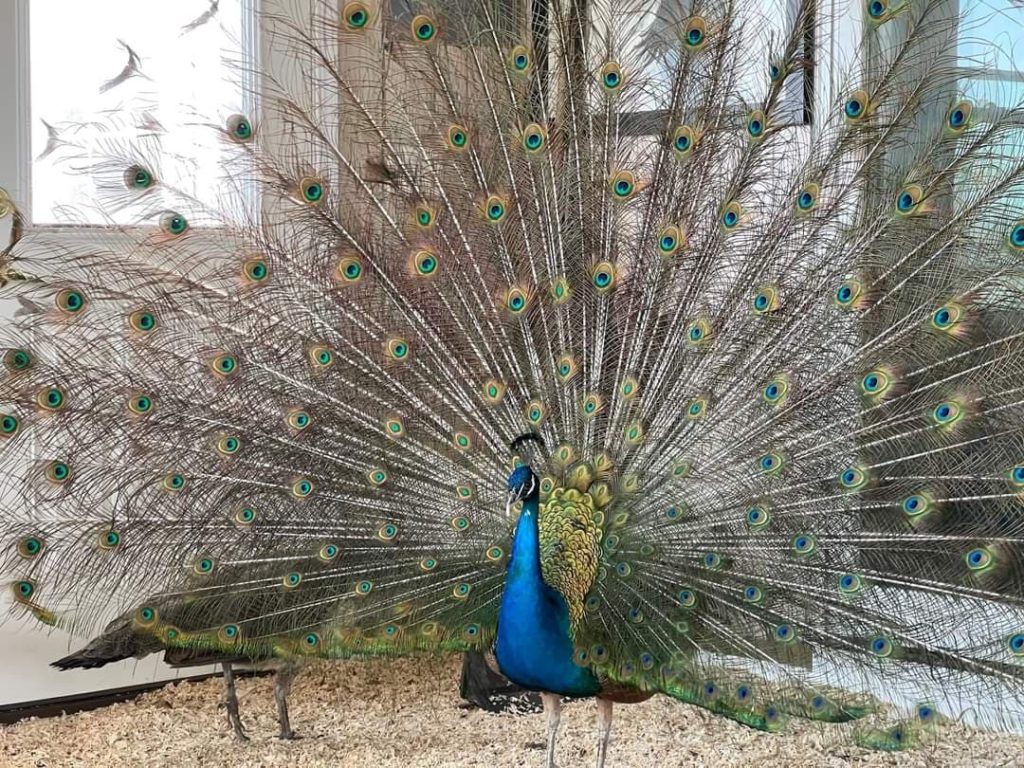
In terms of vocal displays, peacocks make a number of loud vocalizations, some of which sound like a baby screaming, and some of which can sound like a car alarm. Peahens can also vocalize loudly, although generally not as loudly as peacocks. The more peafowl you have, the more frequently they vocalize, and especially during the breeding season. Peafowl are certainly much louder than most birds traditionally kept by humans (with the possible exception of parrots) and so they may not be well suited as residents of urban sanctuaries, unless your neighbors are particularly understanding.
Further, during breeding seasons peahens tend to congregate around a single peacock, in what is known as a “harem.” Single males may consolidate into peacock-only groups as well. You will need to be particularly aware of providing these birds with enough space during these times to avoid scuffles and fights between peacocks, and peahens!
Conclusion
As with any animal species who has been domesticated or “farmed” by humans, it is essential to consider the important impacts of ancestry and domestication on any given species to whom you provide care. Given that peafowl are very close to their wild relations, understanding where they came from reminds us to keep in mind their natural needs, capabilities and behavioral responses when it comes to providing them with appropriate living spaces and enrichment. When it comes to providing sanctuary to peafowl, striking a balance between allowing them to engage in natural behaviors while maintaining our responsibility to their ongoing wellness and safety as their caregivers is critical.
SOURCES:
Chickens: How We Got Here | The Open Sanctuary Project
The Care of Chicken Residents in Extreme Cold | The Open Sanctuary Project
Estimating Species Lifetime Care Costs At Your Animal Sanctuary | The Open Sanctuary Project
Time To Thrive: The Importance Of Enrichment! | The Open Sanctuary Project
Breaking The Mold: How Animal-Centered Design Can Transform Sanctuaries | The Open Sanctuary Project
Peacock Fact Sheet | PBS Nature
Peafowl In History And Culture | Assorted Regards
Can Peacocks Fly | Bird Advisors
Hear the Sound of Peacock Love Made by Trembling Feathers | Audubon








